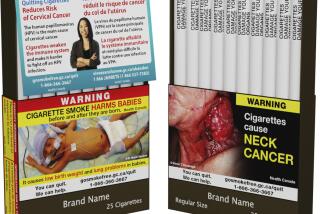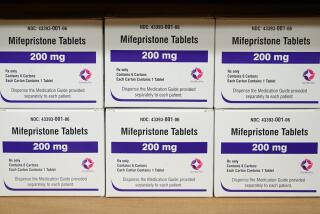Reading the Fine Print Will Get Easier
- Share via
Trying to decipher the medical jargon on drug labels can be daunting for the average consumer. Even doctors have trouble. But the stakes are high: Research suggests that medication errors may be responsible for as many as 100,000 U.S. deaths each year.
The Food and Drug Administration hopes to stem this mounting toll by making drug labels--the package inserts that come with medications--more user friendly. Doctors can then get the crucial information they need at a glance, rather than having to wade through reams of complex medical data.
The new format makes it easier for consumers to read the package inserts, too, so they can be more aware--and thus more vigilant--about possible problems.
“We hope the new labeling will reduce medical errors, which are an important cause of hospitalizations, serious injury and drug interactions,” says Nancy Ostrove, chief of research for the FDA’s Center for Drug Evaluation and Research. “The proposed changes would make pertinent information clear, concise, comprehensive and easily accessible.”
Right now, drug package inserts contain many caveats about potential problems, including possible adverse reactions or interactions with other drugs, buried in fine print that harried physicians often don’t have time to read. Small wonder simple mistakes are often made that can be catastrophic for patients.
“Doctors can miss warnings about drugs, or not prescribe the right dosages,” says Mike Pavlovich, a pharmacist in Torrance and president of the California Pharmacists Assn., a trade group in Sacramento.
The FDA has long known there was a problem, as doctors have complained that the labels are too lengthy and complicated to use efficiently. The agency began surveying physicians in 1992 to determine what changes should be made. Based on these surveys, the agency overhauled product labels.
The new format now has an introductory “highlights” section containing the most crucial information. Physicians identified several categories of information they need upfront: common side effects, significant adverse reactions, drug interactions, proper dosages, how the drug’s effectiveness compares to similar medications, and warnings for specific populations, such as children, pregnant women or the elderly.
Section headings are in a dark bold, enlarged typeface, and the labels are uniform in their presentation, in the same way as food labels list essential nutrition facts.
The FDA also has proposed stamping an inverted black pyramid on novel therapies that are either new formulations or have been on the U.S. market for less then three years. Experts know that unanticipated reactions occur most frequently in newly marketed drugs. This emblem, which is in use in Great Britain, will serve as a signal to doctors to use extra care, and to be on the lookout for rare but potentially serious side effects.
The FDA plans to phase in changes, with the novel labels making their debut within the next year on new drugs. The new labels will be gradually added to drugs already on the market after that.
The agency is still soliciting comments on the proposed changes. If you want to weigh in, the deadline is March 22. The proposed changes are available on FDA’s Web site: https://www.fdagov/ohrms/dockets/98fr/122200a.htm).
Or you can submit written comments to Dockets Management Branch (HFA-305), Docket Number: 00N-1269, Food and Drug Administration, 5530 Fishers Lane, Room 1061, Rockville, MD 20857.
(BEGIN TEXT OF INFOBOX / INFOGRAPHIC)
Easy-to-Read Design
The FDA’s proposed drug information sheet incorporates several innovations that make information more accessible.






